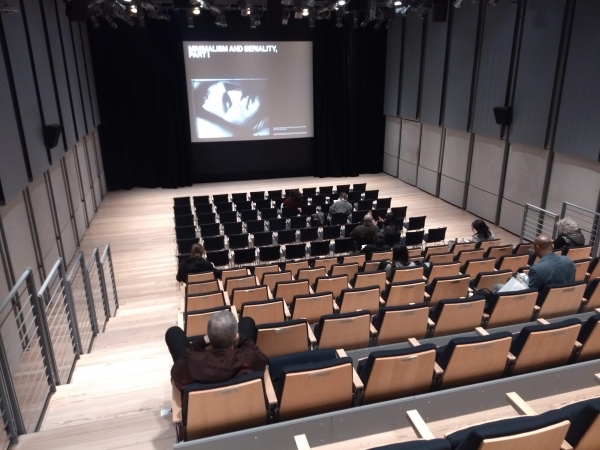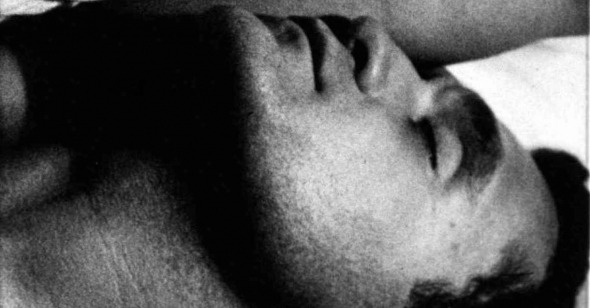Perchance to Dream
By David Schwartz
Sleep
Dir. Andy Warhol, U.S., 1964
Museum of Modern Art Circulating Film Library; Screened at the Whitney Museum of American Art, March 31, 2019
Does Andy Warhol’s Sleep even need to be seen? Discussion about it preceded its existence. In September 1963, four months before its premiere at the Gramercy Arts Theater, Jonas Mekas wrote in The Village Voice: “It doesn’t have to be a great or complex work of art to be a witness of a passionate movement forward. Andy Warhol is in the process of making the longest and simplest movie ever made: an eight-hour long movie that shows nothing but a man sleeping.”
The finished film was actually just five hours and 21 minutes long. After the January 1964 premiere (attended by nine people, two of whom left within a half hour), Mekas wrote a review consisting only of questions: “What does Warhol’s Sleep do? What doesn’t it do? Is it cinema? . . . A Zen Joke? If it makes you angry, why? . . . Why do we go to cinema?”
Famous but rarely seen, Warhol’s films exist more as discussion prompts than actual experiences. After all, anyone can have an opinion about a five-and-a-half hour film titled Sleep. And Warhol’s penchant for such pronouncements as “I like boring things” suggests that maybe there isn’t much to see on the screen—that boredom is the point. But as with all of Warhol’s films—that is, the hundreds of screen tests and feature-length films he made between 1963 and 1968, when he was shot and almost killed by Valerie Solanas and handed the Factory’s film production reins to Paul Morrissey—watching Sleep is much richer and more complex than what is suggested by its minimalist title or synopsis: Warhol’s lover, poet John Giorno, sleeps.
This is not to claim that Sleep is a great work of cinema. Warhol’s very first film, made in the summer of 1963 with a newly acquired 16mm Bolex camera that he barely knew how to use, Sleep is as uneven as it is monumental, yet always the work of an acutely gifted and perceptive artist. Quite possibly inspired by choreographer Yvonne Rainer’s Terrain, an avant-garde dance performance that premiered in April 1963 at the Judson Theater and included a section called “Sleep,” Warhol came up with the idea to film Giorno sleeping for eight hours. But he was hampered by the fact that the camera only accepted 100-foot rolls of film; he could photograph just three minutes at a time.
Warhol emerged from months of filming with just a few hours of usable footage, so he came up with a few gimmicks to lengthen the movie. He slowed down the footage by running it at 16 frames per second instead of the standard 24, and with the help of an editor—14-year-old (!) Sarah Dalton—he simply repeated many of the shots to fill time. Despite the film’s cleanly minimalist concept, the result is a hodgepodge; Sleep is both slow and choppy, with an irregular rhythm. Warhol scholar extraordinaire Callie Angell determined that reel four of the film consists of one shot repeated 20 times over 40 minutes, while reel five has 133 splices, with shots ranging from one to 20 feet.
There is no discernible chronology; the film is an assemblage of shots spliced together to fill 321 minutes. And frankly, hours three and four are pretty boring; but those still seated at that point have given themselves over to the experience and aren’t likely to mind. The chronology that the film is truly interested in isn’t John Giorno’s night of sleep, as much as your night of moviegoing. Few films make you this aware of your surroundings, and of how you are deciding to spend your time.

*****
You arrive at the Whitney Museum on Sunday, March 31, 2019, the last day of the Warhol exhibition, a blockbuster that has drawn many thousands of visitors for the past five months. The galleries closed at 6:00pm, but the film theater reopens at 7:00 for the screening. As she takes your ticket, a bemused guard asks with genuine curiosity why you would want to see this movie of a man sleeping. She says that the screening was almost canceled; just four tickets had been sold by the afternoon.
But when you enter the auditorium, a sleek and comfortably large room with around 200 seats, half at floor-level, half on bleachers—there are about 20 people there. A few more will wander in. Talking Heads music fills the room, perhaps to pump up the viewers—or the projectionist—for the long ride ahead. Warhol liked to show the film with an AM radio playing, a gesture taken from Ken Jacobs’s Blonde Cobra (1963), but for this screening the film will be shown silent. Intentionally or not, a lively soundtrack is provided by the audience. Each disgruntled exit or bathroom break is accompanied by footsteps amplified by creaking wood and closing doors. Coughs, and the sound of repositioning bodies, and occasional laughs punctuate the austere quiet. Nobody snores. The audience watching the show is a large part of the show, and the film is both meditative and interesting. (Besides, most Americans spend more than twice its running time per day looking at screens; the five plus hours don’t actually feel like such a demand.)
But what exactly are we watching? As soon as the room goes dark, and the light from the 16mm projector hits the screen, we are confronted with a vaguely abstract, faintly erotic image. Amid shadows, and layered by film scratches and grain that reveal the materiality of the medium, we see what appears to be a navel. It is a close view of a man’s body, barely moving. The only signs of life are provided by his breathing. (Dalton was reportedly instructed to eliminate any shots that had more than a tiny hint of motion.)
There is an adjustment in the focal length, making the texture of the skin more evident. The image is beautiful and filled with tension—between light and dark, abstraction and plain realism. Throughout the movie, the film exposure varies wildly; parts of the frame are often white with overexposure, others are murky and dark.
Seen with a painter’s eye, Giorno’s body becomes a symphony of shapes and shades of gray, black, and white. His dark hair, eyebrows, closed mouth, and the line of his ass when Warhol lingers on his backside, turn the frame into something that feels more like a charcoal drawing than a photograph.
For several hours, our attention is riveted as we focus on the smallest of details. Warhol’s camera is active, moving from front to back, from below to above Giorno’s body. Sometimes the camera is extremely close, sometimes Warhol gazes from further back. It is the eye of a painter, but also the eye of a lover. The erotic urge is especially evident in Warhol’s earliest films. Sleep was followed by Kiss (a succession of couples kissing), which was followed by three plainly homoerotic works: Haircut (No. 1), Eat, and Blow Job.
But the film’s eroticism is undercut both by its playfully stubborn impassivity, and by the simple fact that the protagonist is sleeping. We watch the entire movie with no idea what he is thinking or feeling. He is, rather, the subject of a visual study that (with the exception of those two boring hours) is always fascinating. Some tension is added by the way that while some images seem perfectly exposed and lit, others feel like mistakes. (Warhol loved to embrace mistakes; the entire first half hour of his Edie Sedgwick film Poor Little Rich Girl is out of focus, leading to an amazing moment when the second reel begins in sharp focus). Close to hour five, Giorno’s mouth flutters and he breathes a bit spastically, like he is about to wake up. Coming after the preceding stillness, the moment hits like an explosion in an action movie. But the film will end without him actually waking.
Warhol’s fascination with duration continued. The following summer, he rented an Auricon movie camera that held 50-minute rolls of 16mm, and made Empire, finally completing the eight-hour movie he intended with Sleep. But Sleep remains an essential and paradoxical film, at once intimate and opaque.
In a movie theater, we—the audience—are usually the sleepers, entering a sort of dream state, joining the world of the characters on screen. Here, the sleeper is onscreen, and despite the fact that he lies there naked before us, we have no access to his thoughts or dreams. Instead—and this is Warhol’s genius—Sleep makes us acutely aware of ourselves, of our perceptions and feelings as we watch, as we sleep, in a sense, with eyes wide open.
